Interview with Director of Photography Peter Rohe | Read more at in70mm.com The 70mm Newsletter |
| Written by: Gerhard Fromm and published 20. July 1984. Reprinted by written permission by: Editor-in-Chief, Ms Evelyn Voigt-Müller of FILM & TV KAMERAMANN. English translation by: Wolfram Hanneman. Prepared for in70mm.com by: Anders M Olsson (Sweden), Gerhard Witte (Germany) and Brian Guckian (Ireland) | Date: 20.09.2013 |
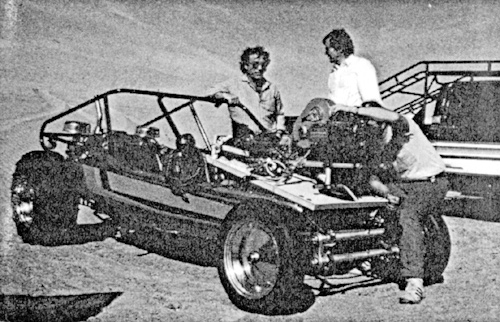 Filming
in Death Valley (left to right) Peter Rohe, Guido Noth, aerial cameraman /
assistant cameraman, and director George Moorse Filming
in Death Valley (left to right) Peter Rohe, Guido Noth, aerial cameraman /
assistant cameraman, and director George Moorse”Auto-E-Motion” is the title of a movie filmed in Super Panavision 70 to be shown exclusively in the new cinema at the BMW Museum in Munich. KAMERAMANN: Mr. Rohe, you’ve just returned from the USA where you and director George Moorse have finished filming “Auto-E-Motion”, a film made for the BMW Museum. What were the tasks that you and the technology were confronted with by this project? PETER ROHE: The basic concept was built on two factors. First of all, movement was to be shown, since the film would be screened in the museum of a car manufacturer. On the other hand, the beauty of the world was to be shown as well. With regards to technology, it was decided from the beginning to use the 70mm format because the film would be shown on an extremely large screen. At 6 x 18 meters, the screen is almost the size of that of a drive-in, but by comparison the auditorium inside the BMW Museum is relatively small. With a capacity of 120 visitors, you are sitting in full view of grain and resolution. | More in 70mm reading: Interview mit Kameramann Peter Rohe Motion pictures photographed in Super Panavision 70 & Panavision System 65 Making of BMW 850i In the Movies with Gerhard Fromm Traumreisen auf breitem Filmband: Das M.C.S.-70-Verfahren Internet link: laserhotline.de kameramann.de BMW Museum |
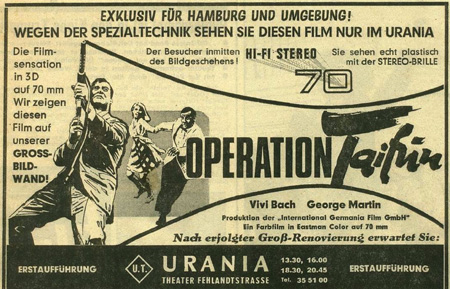 KAMERAMANN: With the 70mm format being almost gone here in Europe, how did you
overcome the technical issues? KAMERAMANN: With the 70mm format being almost gone here in Europe, how did you
overcome the technical issues?PETER ROHE: During my time as an assistant I spent several years at MCS (Modern Cinema Systems), which built cameras for the 70mm format during the ’60s. So I worked on several big movies like "Die schwarze Tulpe" (The Black Tulip, 1964), "Meine Lieder, meine Träume" (The Sound of Music, 1965), "Die tollkühnen Männer in ihren fliegenden Kisten" (Those Magnificent Men in Their Flying Machines, 1965) and later on became camera operator for the 70mm 3D movie "Operation Taifun" (1967). These experiences with 70mm also enabled me about a year ago to make a Super 3D 70mm film to be shown at trade fairs. We decided to use Panavision for the BMW project because they still offer a wide range of cameras and equipment. | |
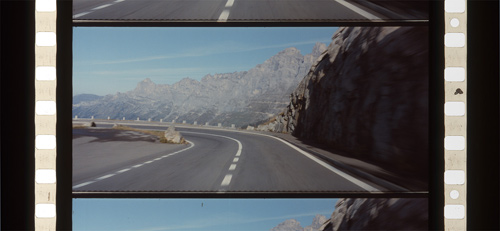 KAMERAMANN: Which specific requirements did you have to take care of when
choosing your equipment? KAMERAMANN: Which specific requirements did you have to take care of when
choosing your equipment?PETER ROHE: Since most of the shots would be made while moving, we needed a small solid camera which could be attached to different types of vehicles like helicopters, cars, buggies, etc. For this I chose the Panavision 65mm field camera with 150m magazines. KAMERAMANN: Mr. Rohe, when there is discussion about the 70mm format, there is always reference to 65mm cameras as well. Could you explain this to our readers? PETER ROHE: When filming for 70mm release prints, the negative is only 65mm wide, which considerably saves on weight and material. The magazines as well as the cameras can be smaller. The perforations are in the same position on the negative and on the print. However the print is 2.5mm wider on both sides. With 70mm prints you always use magnetic sound tracks. To make use of multichannel sound, two tiny audio tracks are positioned between the frame and the perforations. Two additional magnetic stripes are located on the wider edges of the print, thus enabling one to store the high quality 6-track stereophonic sound requested by the BMW Museum. | |
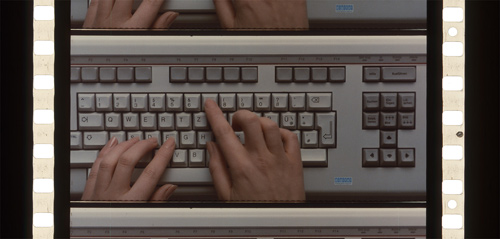 KAMERAMANN: Mr. Rohe, although the technology obviously wasn't new to you,
didn't you also have to overcome some obstacles? KAMERAMANN: Mr. Rohe, although the technology obviously wasn't new to you,
didn't you also have to overcome some obstacles? PETER ROHE: Yes indeed – it all started with searching for a solid system by means of which you could attach the camera to the vehicles. We were able to obtain a highly professional system from Guido Noth from Biel in Switzerland, who in addition was hired as an assistant for the film. His system basically consists of different sized aluminium tubes which could be combined in a lot of ways by means of custom-manufactured connectors. The really special thing, however, is the Super Grip suction cups, which could be checked for correct vacuum and pumped out by means of thin hoses running from inside the vehicle. For our special needs with the helicopter shots Guido also developed a Body Mount. Using this we were able to attach the camera underneath the helicopter, enabling filming in the direction of flight. By means of a specially-made hydraulic system, the whole attachment could be partially retracted when landing. Within certain limitations the camera could also be moved up and down. | |
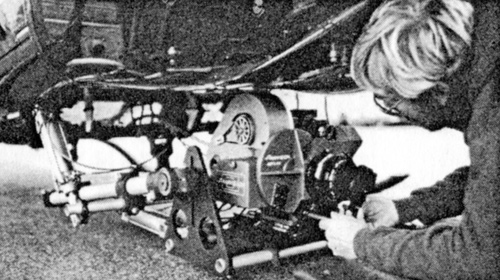 Peter
Rohe is mounting the Panavision camera under the helicopter. The camera
mount was developed by Guido Noth Peter
Rohe is mounting the Panavision camera under the helicopter. The camera
mount was developed by Guido NothKAMERAMANN: How could you control camera and picture during these situations? PETER ROHE: Here we had a real problem, because at Panavision the 65mm cameras had been put in storage for almost twenty years. For instance they had to manufacture a unique video adaptation for us so that we could check the picture during the previously-mentioned shots. Since the camera did not have a reflex system, but only a static semi-reflex, a relatively good picture, as well as no flickering during the running of the camera resulted. A viewer-open automation wasn't needed either. KAMERAMANN: So you could begin filming without any problems once the camera arrived from the USA? PETER ROHE: Yes, in principle. However during one of the first shots in Switzerland with the camera mounted underneath the helicopter some problems occurred. What we thought would happen, did: the camera was used to the California sun and did not get into gear because of the cold. Adding to the problem was the fact that we had to keep the battery inside the helicopter to be able to switch the camera on and off. We also couldn't exactly tell when the reel of film was finished, because there was no possibility of control. Having to adjust the aperture before take-off was a handicap. During the flight, very often the lighting conditions would change, or you suddenly encountered back light. | |
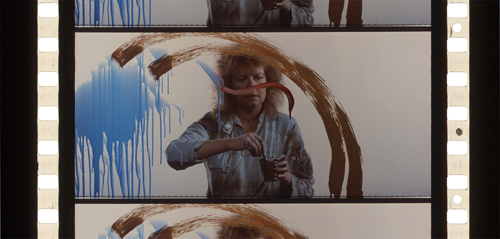 KAMERAMANN: You were already in production at that time. How did you manage? KAMERAMANN: You were already in production at that time. How did you manage?PETER ROHE: Just over a weekend, Filmtechnik Fromm, a company located south-east of Munich, came to help us. First of all a “Heating Barney” was constructed. With six flexible heating elements, the camera could be held in stand-by. By using a remote control which had already been used for the Bavaria-Film "Das Boot" (1981), we were able to mount the battery alongside the camera and did not suffer any further power loss. When switching on the camera there was an additional monitor with a counter inside the control box. You could adjust this counter very precisely so that we knew exactly when the reel of film inside the magazine was at its end. Using the same remote control we were able to adjust the aperture via a servodrive attached to the lens. Finally, a piece of curious information: Kodak was still able to deliver 65mm film material; however, they did not have any suitable bobbins or film cans, which we really needed for separating or for leftovers. So Gerhard Fromm just glued together two 35mm bobbins and trimmed them down to 65mm. And for spare film cans, we used a specific type of Danish cookie jar! | |
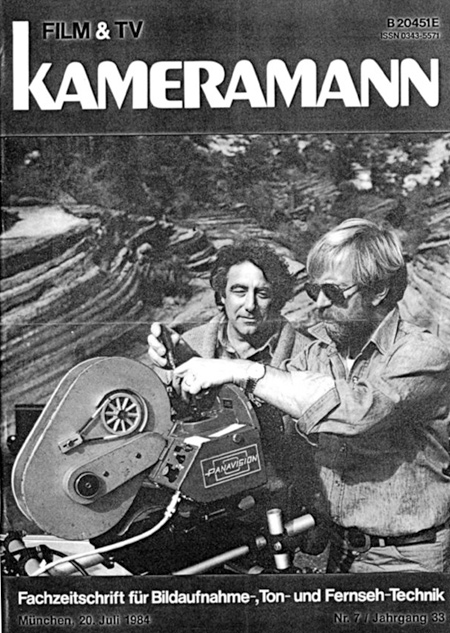 KAMERAMANN:
Now, there are not only helicopter and car shots in the finished film – what
else did you use to breathe life into the images? KAMERAMANN:
Now, there are not only helicopter and car shots in the finished film – what
else did you use to breathe life into the images?PETER ROHE: George Moorse had the idea of shooting certain scenes in slow motion. For this purpose a rackover Mitchell camera from Panavision was used. That is a camera from the good old days in Hollywood, where you moved the camera body to one side when you wanted to adjust the framing. Then a viewfinder is slipped in behind the lens. During the actual filming the cameraman just has a sideviewer. Despite its old age, the camera ran without any problems at 80fps. Underwater shots were also taken for the film, for which experienced diving cameraman Randy Miller was hired in Hawaii. As already said, Panavision in Los Angeles still has the full range of equipment for filming in 65mm. So we were able to get our hands on a very well made underwater camera housing. KAMERAMANN: To come to an end – could you tell us a bit about the processing possibilities in the lab? PETER ROHE: Yes – generally we found that 65/70mm film is no longer processed in Europe. There are still processing units installed in Paris, Madrid and London, which could be re-activated for a feature length motion picture, but not for such a relatively small production like ours. There is still a lab owned by MGM in Los Angeles which processes 65mm negative at short notice. For copying the dailies and striking the prints you can choose between MGM and Technicolor. Please keep in mind that dailies are compressed anamorphically onto 35mm film. The complete post-production process therefore can be handled in ’Scope on a standard flatbed editor. The 65mm negative is cut according to the edited 35mm film. Only after this are the expensive 70mm film prints made. | |
| Go: back - top - back issues - news index Updated 21-01-24 |
